This profile of Falmouth Central Wesleyan Chapel has been compiled by Jo Lewis and Tony Mansell.
Located in Market place, on the southern side of The Moor.
In the mid-C18, the Falmouth Methodists were meeting in a room on Porhan Hill, and there was probably also a meeting place off Church Street. John Wesley first visited Falmouth in July 1745 where he was confronted by a mob which he appeased, but when he visited again in August 1789, he found the townspeople much changed.
1791 Wesleyan Chapel

Wesleyan Church, The Moor, built circa 1791 and described as a simple building with plenty of space and seating 1143 people. https://thepoly.org/history-archive/item/77/wesleyan-church
1791: Build date.
1814: Chapel enlarged to accommodate a growing congregation.
1828: The site was bought by the trustees.
1837 Wesleyan Chapel
1837: Build date.
A second building could seat 1230: it formed the basis of the final chapel.
1876 Wesleyan Chapel
The trustees had held an architectural competition, and the design chosen was that by James Hicks of Redruth (1846-1896), a Cornishmen who built a successful practice in the county. The designs were published in The Building News on 1 May 1874, and the foundation stone laid on 30 July 1874. The dedication service took place on 26 May 1876, with the new chapel having 1400 sittings, one of the largest in Cornwall and a cost of £6,000. The opening of the new Wesleyan chapel was described as the most important event, alongside the opening of the 1791 chapel, to have occurred in connection with Falmouth Wesleyanism, as it was considered to mark the growth and establishment of Wesleyan Methodism in Falmouth.
1894: “Extensive alterations and repairs” were carried out under the guidance of Hicks with the chapel reopened in June of that year.
1888: Schoolrooms extended and memorial stones laid that November.
Heritage Gateway: Large Wesleyan Methodist chapel, built 1874-6 on site of original 1791 Wesleyan chapel. Slightly altered 1956 (following bomb damage during the war). Dressed stone walls; dry slate roof. Eclectic style, part of good group of public buildings. Listed in Stell (b1). https://www.heritagegateway.org.uk/Gateway/Results_Single.aspx?uid=MCO32167&resourceID=1020
1932: The Wesleyan, Primitive Methodist and the United Methodist Church amalgamated to become the Methodist Church of Great Britain.
1932: Became Falmouth Wesley Methodist Church – part of the new Falmouth Methodist Circuit.
The Wesleyan chapel was used as a hostel for troops during the Second World War.
On the evening of Wednesday 9th October 1940, an incendiary bomb hit the building and exploded in the ground-floor schoolroom – which was being used as a canteen – and the chapel’s windows were blown out. Three soldiers and two civilians were killed immediately, with a further soldier dying from his wounds the following day, and many injured.
Meetings continued in an adjacent building, but the chapel suffered bomb damage again on 13th May 1941. The shell of the building remained intact but the inside was very badly damaged.
 The bomb-damaged chapel (Photo: courtesy Alan Cox of Penryn & Falmouth Old Cornwall Society)
The bomb-damaged chapel (Photo: courtesy Alan Cox of Penryn & Falmouth Old Cornwall Society)
 The bomb-damaged chapel (Photo: courtesy Alan Cox of Penryn & Falmouth Old Cornwall Society)
The bomb-damaged chapel (Photo: courtesy Alan Cox of Penryn & Falmouth Old Cornwall Society)
It stood derelict from 13th May 1941 until March 1956, when it was repaired following a redesign by Geoffrey B. Drewitt of Penzance. Whilst the building was being repaired the congregation moved to Berkeley Vale Methodist for ten years with the joint society being called Falmouth Central Methodist Church.
The repaired church accommodation was reduced to 620, but the building was reported as being “as modern as the trustees could make it.” As a part of the rebuild, the gallery space was replaced by a floor making an upstairs Church and a large hall underneath. The cost of this was £44,000 and the reconstructed church was dedicated on 14th March 1956. The joint society moved into it and Berkeley Vale Chapel closed.
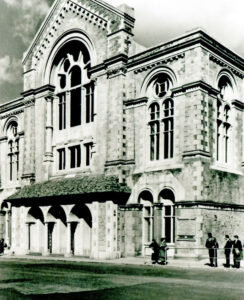 Falmouth Central (Photo: courtesy Alan Cox of Penryn & Falmouth Old Cornwall Society)
Falmouth Central (Photo: courtesy Alan Cox of Penryn & Falmouth Old Cornwall Society)
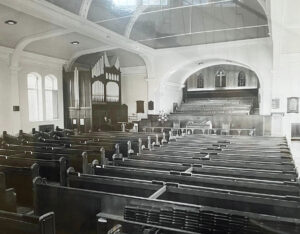 Before removal of pews (Photo: Barry West)
Before removal of pews (Photo: Barry West)
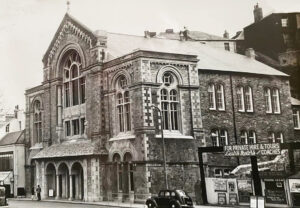 1979: Became Falmouth Methodist Church when Pike’s Hill Chapel closed, and a new joint society was formed.
1979: Became Falmouth Methodist Church when Pike’s Hill Chapel closed, and a new joint society was formed.
2008: The church has become part of the newly formed Falmouth and Gwennap Circuit.
2008: The pews from the main body of the church were removed to provide more flexibility.
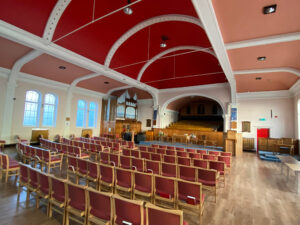 (Photo: Barry West)
(Photo: Barry West)
Sunday 16 January 2022: The last service was held at the church.
The congregation moved to New Street Hall, in New Street, behind the Parish Church of King Charles the Martyr. https://falmouthmethodist.org.uk/
The Church was sold and in 2024 it was boarded up.
2023: Planning negotiations in progress perhaps to create commercial spaces on the ground floor, apartments at first floor and the retention of the second floor for community and private function space.
September 2024: Planning approval still awaited.
Following closure it was Grade 2 listed: Former Wesleyan Methodist chapel, 1874-1876 by James Hicks, with alterations in 1888 and 1894; exterior altered and interior rebuilt in 1956 by Geoffrey B Drewitt, following bomb damage.
Further reading:
https://kresenkernow.org/SOAP/search/RelatedNameCode.keyword/CRO%7CUK%7C527/
https://historicengland.org.uk/listing/the-list/list-entry/1481824?section=official-list-entry

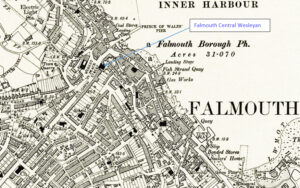 Map:
Map: